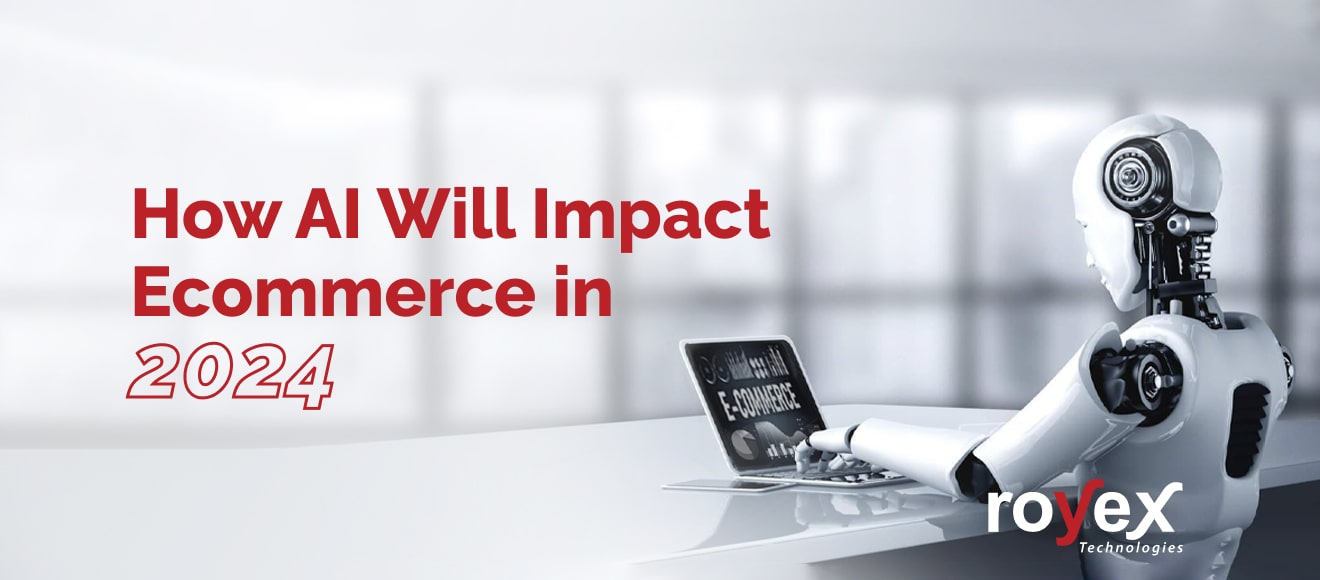
How AI Will Impact Ecommerce in 2024
Artificial intelligence (AI) emerges as a revolutionary force poised to redefine the way businesses operate and consumers engage in the digital marketplace. As we embark on the journey into 2024, the intersection of AI and e-commerce promises a myriad of transformative impacts, from enhanced customer experiences to streamlined operations and unprecedented levels of personalization. This article delves into the profound ways AI is set to shape the future of e-commerce, unraveling the intricacies and potentials that lie ahead.
Artificial intelligence, with its ability to simulate human-like intelligence and decision-making, has found fertile ground for growth and application in the e-commerce sector. The genesis of this synergy can be traced back to the increasing volume of data generated by online activities, coupled with the computational power needed to analyze and derive meaningful insights from this vast ocean of information. In the nascent stages, AI applications in e-commerce were primarily focused on recommendation engines, chatbots, and predictive analytics. However, as we stand on the precipice of 2024, the scope and impact of AI in e-commerce are poised to reach unprecedented heights.
Here are the way AI will immensely impact Ecommerce in 2024:
1.Hyper-Personalized Shopping Experiences

AI algorithms, fueled by machine learning and data analytics, are becoming adept at understanding and predicting individual consumer preferences. In 2024, e-commerce platforms are set to deliver hyper-personalized shopping experiences, where product recommendations, content, and promotional offers are finely tuned to align with the unique tastes and behaviors of each user. This level of personalization not only enhances user satisfaction but also contributes to increased conversion rates and customer loyalty.
The future of hyper-personalization transcends product recommendations; it's about understanding the context in which users engage with the platform. AI algorithms in 2024 will factor in contextual elements such as the user's location, the time of day, and even the device being used. For instance, a user browsing the platform on a weekend morning might receive recommendations for leisurewear or brunch-related items, while the same user in the evening might be presented with options for dinnerware or entertainment products.
While past purchases remain a crucial aspect of personalization, the AI algorithms of 2024 venture beyond transactional history. These algorithms delve into a user's entire digital footprint, encompassing likes, shares, and even the duration spent engaging with specific products. By understanding the nuances of user preferences beyond direct purchases, AI can predict preferences for new or complementary products. This foresight not only broadens the scope of recommendations but also introduces users to items they might not have considered, creating a sense of delightful serendipity in the shopping journey.
The intersection of dynamic pricing and hyper-personalization is poised to redefine how e-commerce platforms approach pricing strategies. In 2024, AI algorithms not only analyze market trends and competitor pricing but also consider an individual user's response to discounts and promotions. If a user consistently engages with discounted items or shows a propensity to make purchases during promotional periods, the algorithm adapts pricing dynamically for that specific user. This level of granular pricing optimization ensures that discounts are not only strategic but also resonate with the individual user's behavior and preferences.
2. Visual Search and Image Recognition

The integration of AI-powered visual search and image recognition technologies is set to revolutionize how consumers discover and explore products online. Imagine a scenario where users can snap a picture of an item they desire, and AI algorithms instantly scour the digital marketplace to find identical or similar products. This not only simplifies the search process but also opens new avenues for impulse purchases and serendipitous discoveries.
Visual search transcends the limitations of traditional text-based queries, allowing users to initiate searches using images as queries. In 2024, this technology goes beyond the rudimentary identification of objects; AI algorithms comprehend the context, style, and even subtle nuances within images. Users can snap a picture of a fashion item, piece of furniture, or any object of interest, and the AI, powered by advanced image recognition, can precisely identify the item and provide a curated set of visually similar products. This shift from keyword-centric searches to visual queries marks a paradigm shift in how users interact with e-commerce platforms.
The evolution of image recognition extends beyond mere identification; it now includes understanding users' style preferences and aesthetic inclinations. In 2024, AI algorithms delve into the intricate details of images, discerning patterns, color palettes, and design elements. For instance, if a user uploads an image of a modern and minimalist living room, the algorithm not only identifies the furniture but also considers the overall aesthetic. Subsequent recommendations align with the user's style, ensuring a more cohesive and satisfying shopping experience that resonates with individual tastes.
Visual search, powered by advanced image recognition, opens the door to augmented discovery. Users exploring a particular product can leverage visual similarity to discover a broader range of options that align with their preferences. For instance, if a user admires a specific pair of shoes, visual search can present alternatives that share similar design elements, color schemes, or even brand aesthetics. This augmented discovery mechanism transforms the shopping journey into a visually rich exploration, introducing users to products they might not have encountered through traditional search methods.
3. Conversational Commerce and AI-Powered Chatbots

The rise of conversational commerce, facilitated by AI-powered chatbots and virtual assistants, is set to redefine customer interactions in 2024. These chatbots, armed with natural language processing capabilities, engage users in meaningful conversations, offering assistance, answering queries, and even facilitating transactions. The result is a seamless and responsive customer service experience that transcends the limitations of traditional communication channels.
The evolution of AI-powered chatbots in 2024 transcends the conventional boundaries of transactional interactions. These chatbots are not mere conduits for processing orders or answering FAQs; they are conversational agents that engage users in meaningful and context-aware conversations. Whether a user is seeking product recommendations, inquiring about order status, or expressing feedback, chatbots are equipped to navigate the intricacies of human-like conversation. This shift from transactional to conversational interactions fosters a sense of connection and personalization, transforming customer engagement into a dynamic dialogue.
At the heart of effective conversational commerce lies the advancement of Natural Language Processing (NLP) capabilities within AI-powered chatbots. In 2024, these chatbots are adept at understanding and interpreting the nuances of human language. Users can communicate with chatbots in a manner that feels natural, using colloquial language, asking follow-up questions, and even expressing emotions. This sophisticated NLP integration ensures that interactions with chatbots mirror the fluidity of human conversation, enhancing user satisfaction and eliminating the stilted and robotic experiences of the past.
One of the defining features of AI-powered chatbots in 2024 is their heightened contextual awareness and memory. These chatbots can remember previous interactions and maintain context throughout a conversation. For instance, if a user inquires about product availability and later asks about shipping options, the chatbot seamlessly retains the context of the conversation. This continuity ensures that users do not have to repeat information, creating a more efficient and personalized experience that mirrors the continuity of human conversations.
4. Dynamic Pricing Optimization

AI algorithms are becoming increasingly sophisticated in analyzing market trends, competitor pricing strategies, and consumer behavior in real-time. This evolution empowers e-commerce businesses to implement dynamic pricing models that adjust in response to fluctuations in demand, supply chain dynamics, and competitive landscapes. The result is optimized pricing strategies that maximize revenue while remaining agile in dynamic market conditions.
Dynamic Pricing Optimization in 2024 is synonymous with real-time market intelligence. AI algorithms continuously scour the digital marketplace, analyzing competitors' pricing strategies, monitoring supply and demand fluctuations, and considering external factors such as economic conditions. This real-time awareness enables e-commerce businesses to adjust prices dynamically, ensuring they remain competitive, responsive to market changes, and positioned strategically within the pricing spectrum.
A hallmark of Dynamic Pricing Optimization is the ability to tailor prices based on individual customer behavior. In 2024, AI algorithms delve into the granular details of customer interactions. Factors such as past purchase history, frequency of visits, time spent on the platform, and responsiveness to discounts are analyzed to determine optimal prices for individual users. This individualized approach not only maximizes revenue by offering personalized discounts but also fosters a sense of value and loyalty among customers.
The era of fixed pricing strategies gives way to adaptive pricing in 2024. AI algorithms adapt pricing strategies based on various parameters, including product popularity, inventory levels, and even external events such as sales promotions or seasonal trends. For instance, if a product experiences a sudden surge in demand, the algorithm can automatically adjust the price to capture the increased value. This adaptability ensures that e-commerce businesses can optimize pricing strategies to align with diverse scenarios and capitalize on emerging opportunities.
Dynamic Pricing Optimization extends beyond static promotions to dynamic discounts tailored to individual users. AI algorithms analyze user behavior, purchase histories, and response patterns to offer personalized discounts in real-time. For example, a user who consistently abandons their cart may receive a targeted discount to encourage completion of the purchase. This dynamic approach not only enhances the chances of conversion but also ensures that discounts are strategically deployed to users who are most likely to respond positively.
5. Supply Chain Optimization

AI's impact on e-commerce extends beyond customer-facing applications to the very foundations of supply chain management. AI-driven analytics predict demand patterns, optimize inventory levels, and streamline logistics, contributing to more efficient and cost-effective supply chain operations. This results in faster order fulfillment, reduced operational costs, and an overall improvement in the agility of e-commerce businesses.
Supply Chain Optimization is empowered by predictive analytics that transforms data into actionable insights. AI algorithms analyze historical data, market trends, and even external factors such as weather patterns or social trends to predict future demand accurately. In 2024, e-commerce businesses leverage these insights to anticipate fluctuations in demand, plan inventory levels accordingly, and ensure that products are available when and where customers need them. This proactive approach minimizes stockouts, reduces excess inventory, and enhances overall supply chain efficiency.
The era of static inventory management gives way to dynamic inventory strategies in 2024. Supply Chain Optimization ensures that inventory levels are not fixed but adapt in real-time based on demand patterns, seasonality, and market dynamics. AI algorithms continuously analyze data to adjust reorder points, safety stock levels, and replenishment schedules. This dynamic inventory management approach enables e-commerce businesses to optimize stock levels, minimize holding costs, and respond swiftly to changes in consumer preferences or market conditions.
Supply Chain Optimization extends beyond the boundaries of individual businesses, fostering collaborative relationships with suppliers. In 2024, e-commerce platforms work closely with suppliers, leveraging technology to share real-time information on inventory levels, production schedules, and quality control. This collaboration ensures that the entire supply chain ecosystem operates with synchronicity, reducing lead times, minimizing disruptions, and enhancing overall agility.
The integration of blockchain technology in Supply Chain Optimization brings unprecedented levels of transparency and traceability. Each transaction and movement within the supply chain is recorded on a secure and immutable blockchain, offering a transparent and auditable trail. This not only enhances trust within the supply chain but also enables businesses to trace the origin and journey of products. In 2024, blockchain ensures that ethical and sustainable sourcing practices can be verified, aligning with the growing consumer demand for transparent and socially responsible supply chains.
As we traverse the landscape of 2024, the symbiotic relationship between AI and e-commerce unveils a panorama of possibilities and transformations. From elevating the user experience through hyper-personalization to optimizing every facet of business operations, AI is the catalyst propelling e-commerce into a new era. The journey ahead holds the promise of more intuitive, efficient, and personalized online shopping experiences, where the boundaries between virtual and physical commerce continue to blur. The impact of AI on e-commerce is not just a technological evolution; it's a narrative of innovation, empowerment, and a glimpse into the future of digital commerce.
Royex Technologies is a leading e-commerce development company in Dubai. If you plan to design/redesign your website or launch an e-commerce platform, our 24*7 technical teams will give you design and development support. Let Royex’s web development team help develop your e-commerce store to drive more qualified visitors to your site and convert those visitors into leads and sales.
Check our portfolio to see our previous works. Contact us via email at info@royex.net or call us at +971566027916. To get started with us.





